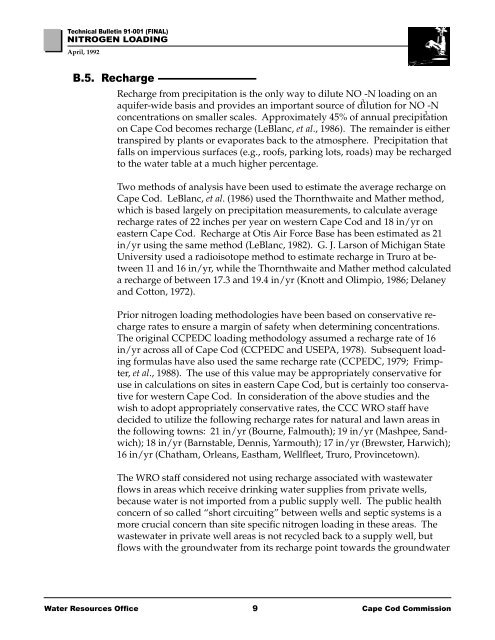Technical Bulletin 91-001 Nitrogen Loading - Cape Cod Commission
Technical Bulletin 91-001 Nitrogen Loading - Cape Cod Commission
Technical Bulletin 91-001 Nitrogen Loading - Cape Cod Commission
Create successful ePaper yourself
Turn your PDF publications into a flip-book with our unique Google optimized e-Paper software.
<strong>Technical</strong> <strong>Bulletin</strong> <strong>91</strong>-<strong>001</strong> (FINAL)<br />
NITROGEN LOADING<br />
April, 1992<br />
B.5. Recharge<br />
Recharge from precipitation is the only way to dilute NO -N loading on an<br />
3<br />
aquifer-wide basis and provides an important source of dilution for NO -N<br />
3<br />
concentrations on smaller scales. Approximately 45% of annual precipitation<br />
on <strong>Cape</strong> <strong>Cod</strong> becomes recharge (LeBlanc, et al., 1986). The remainder is either<br />
transpired by plants or evaporates back to the atmosphere. Precipitation that<br />
falls on impervious surfaces (e.g., roofs, parking lots, roads) may be recharged<br />
to the water table at a much higher percentage.<br />
Two methods of analysis have been used to estimate the average recharge on<br />
<strong>Cape</strong> <strong>Cod</strong>. LeBlanc, et al. (1986) used the Thornthwaite and Mather method,<br />
which is based largely on precipitation measurements, to calculate average<br />
recharge rates of 22 inches per year on western <strong>Cape</strong> <strong>Cod</strong> and 18 in/yr on<br />
eastern <strong>Cape</strong> <strong>Cod</strong>. Recharge at Otis Air Force Base has been estimated as 21<br />
in/yr using the same method (LeBlanc, 1982). G. J. Larson of Michigan State<br />
University used a radioisotope method to estimate recharge in Truro at between<br />
11 and 16 in/yr, while the Thornthwaite and Mather method calculated<br />
a recharge of between 17.3 and 19.4 in/yr (Knott and Olimpio, 1986; Delaney<br />
and Cotton, 1972).<br />
Prior nitrogen loading methodologies have been based on conservative recharge<br />
rates to ensure a margin of safety when determining concentrations.<br />
The original CCPEDC loading methodology assumed a recharge rate of 16<br />
in/yr across all of <strong>Cape</strong> <strong>Cod</strong> (CCPEDC and USEPA, 1978). Subsequent loading<br />
formulas have also used the same recharge rate (CCPEDC, 1979; Frimpter,<br />
et al., 1988). The use of this value may be appropriately conservative for<br />
use in calculations on sites in eastern <strong>Cape</strong> <strong>Cod</strong>, but is certainly too conservative<br />
for western <strong>Cape</strong> <strong>Cod</strong>. In consideration of the above studies and the<br />
wish to adopt appropriately conservative rates, the CCC WRO staff have<br />
decided to utilize the following recharge rates for natural and lawn areas in<br />
the following towns: 21 in/yr (Bourne, Falmouth); 19 in/yr (Mashpee, Sandwich);<br />
18 in/yr (Barnstable, Dennis, Yarmouth); 17 in/yr (Brewster, Harwich);<br />
16 in/yr (Chatham, Orleans, Eastham, Wellfleet, Truro, Provincetown).<br />
The WRO staff considered not using recharge associated with wastewater<br />
flows in areas which receive drinking water supplies from private wells,<br />
because water is not imported from a public supply well. The public health<br />
concern of so called “short circuiting” between wells and septic systems is a<br />
more crucial concern than site specific nitrogen loading in these areas. The<br />
wastewater in private well areas is not recycled back to a supply well, but<br />
flows with the groundwater from its recharge point towards the groundwater<br />
Water Resources Office 9<br />
<strong>Cape</strong> <strong>Cod</strong> <strong>Commission</strong>
















